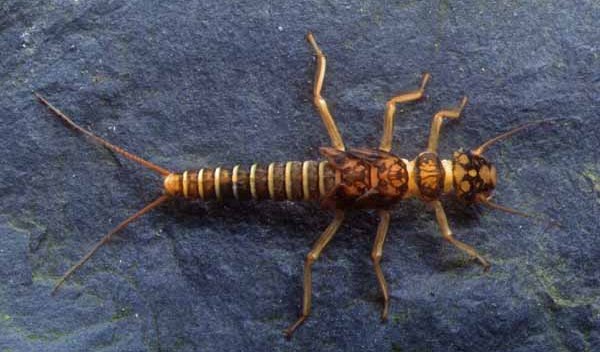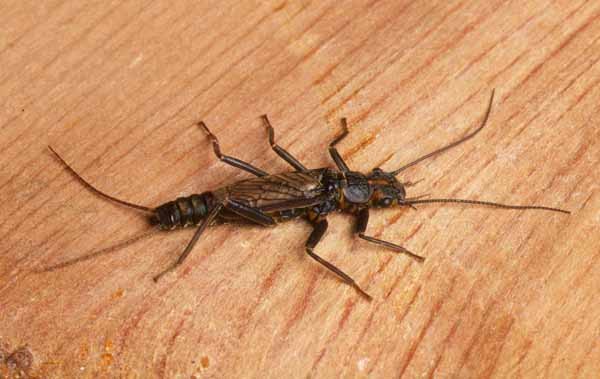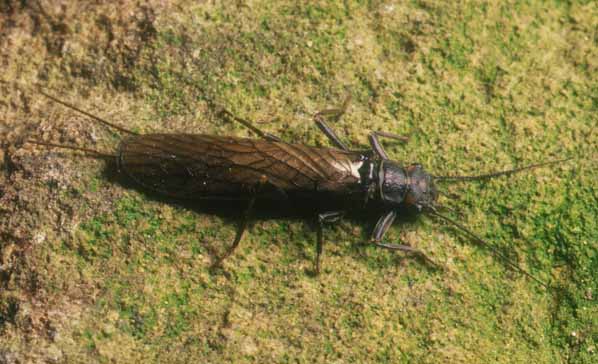Perlodes mortoni - Orange-striped Stonefly
Phylum: Arthropoda - Class: Insecta - Order: Plecoptera - Family: Perlodidae

Nymph
Until recently, this large stonefly was recorded in Britain as it is elsewhere in Europe as Perlodes microcephalus (syn. Perlodes microcephala), but now British populations of this stonefly have been separated from the European species and the scientific name Perlodes mortoni applies to the Orange-striped Stonefly in Britain.

Adult male
The differences are not major, and certainly any trout fisher who has an artificial fly for imitation Perlodes mortoni will find that it is just as effective on the continent! .
Although common in many rivers, Orange-striped Stonefly nymphs live beneath stones and hatch into winged adults by crawling onto exposed rocks in the shallows. It is difficult to mimic this behaviour with an artificial fly.
The nymphs prefer well oxygenated water, and in warm weather they often congregate in the fast riffles. They take two years or more to reach maturity, unlike many of the smaller species which have a one-year life cycle. Trout rummage among the smaller stones to disturb stonefly nymphs from their hideouts.

Adult female
These big flies appear from the end of March until the middle of June, with the peak of the hatch usually occuring in May. The males have very short wings and are unable to fly, and so the females go about the business of courting before they fly across the river and dip down to lay their eggs.
Artificial stoneflies
Several accurate adult stonefly imitations have been devised for dry fly fishing, but on tumbling streams a general imitation such as a Grey Duster seems to work perfectly adequately.
Stonefly nymphs can be imitated by any slim-bodied darking nymph pattern. A Pheasant Tail Nymph is usually effective, and to imitate the nymph of the Orange-striped Stonefly a size 10 long-shank hook is about right.
References
Pryce, D., Macadam, C., & Brooks, S. (2007) Guide to the British Stonefly (Plecoptera) Families: adults and larvae. Taunton: Field Studies Council.
Hynes, H.B.N. (1977) Adults and Nymphs of British Stoneflies (Plecoptera). Ambleside: Freshwater Biological Association.
Excited by rivers and streams? So are we, and we're pretty sure you would find the Winding River Mystery trilogy of action-packed thrillers gripping reading too. Dead Drift, Dead Cert, and Dead End are Pat O'Reilly's latest river-based novels, and now they are available in ebook format. Full details on our website here...
Buy each volume in ebook format for only £2.47 on Amazon... Paperbacks also available on Amazon at £6.95 each. All proceeds go towards keeping the First Nature website online.
Please Help Us: If you have found this information interesting and useful, please consider helping to keep First Nature online by making a small donation towards the web hosting and internet costs.
Any donations over and above the essential running costs will help support the conservation work of Plantlife, the Rivers Trust and charitable botanic gardens - as do author royalties and publisher proceeds from books by Pat and Sue.
